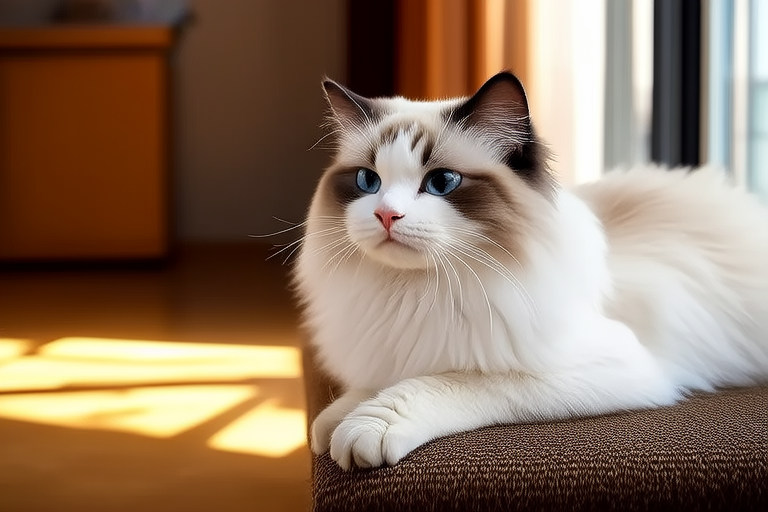The Ultimate Guide to Keeping Your Ragdoll Happy and Healthy
Ragdolls are one of the most affectionate and gentle cat breeds, known for their laid-back personalities and stunning blue eyes. Their name comes from their tendency to go limp when picked up, much like a rag doll. However, just like any other pet, they require specific care to thrive. This guide will walk you through various aspects of keeping your Ragdoll happy and healthy.
Diet
Proper nutrition is vital for maintaining your Ragdoll’s health. Ragdolls have a medium build and can be prone to obesity if overfed. Therefore, it’s crucial to provide them with a balanced diet that meets their nutritional needs without exceeding caloric requirements.
- High-Quality Cat Food: Choose a high-quality commercial food formulated for adult cats or kittens, depending on your Ragdoll’s age. Look for foods that list meat as the primary ingredient and avoid those with fillers like corn or wheat.
- Portion Control: Measure out meals rather than leaving food out all day. Overeating can lead to weight gain and related health problems such as diabetes.
- Water: Fresh water should always be available. Consider using a pet fountain to encourage drinking, as flowing water mimics natural sources and may appeal more to your cat.
- Treats: While treats are enjoyable, they should make up no more than 10% of your cat’s daily calorie intake. Opt for low-calorie options like air-popped popcorn (without butter) or freeze-dried meat snacks.
Exercise
Ragdolls are generally not overly active, but they still need regular physical activity to stay fit. Encourage playtime to keep them engaged and prevent boredom.
- Interactive Toys: Use toys that stimulate hunting instincts, such as feather wands or laser pointers. Rotate toys periodically to maintain interest.
- Climbing Structures: Provide climbing trees or shelves where your Ragdoll can explore and climb. This helps develop muscle strength and coordination.
- Play Sessions: Aim for at least two 15-minute play sessions daily. These interactions also strengthen the bond between you and your pet.
Grooming
Ragdolls have semi-longhair coats that require regular grooming to prevent matting and hairballs. Their coat is typically soft and silky, but it can become tangled if not cared for properly.
- Bathing: Bathing should be done every few months. Use a gentle, cat-specific shampoo and ensure thorough rinsing to remove all soap residue.
- Brushing: Brush your Ragdoll at least once a week, preferably twice. A slicker brush works well for removing loose hairs and preventing mats.
- Nail Trimming: Trim nails every two weeks. Use nail clippers designed for cats, and take care not to cut the quick, which contains blood vessels.
- Toothbrushing: Dental hygiene is important. Introduce tooth brushing gradually using a pet-safe toothpaste and soft-bristled brush.
Common Health Issues
While Ragdolls are generally healthy, they can be predisposed to certain conditions. Early detection and management are key to ensuring a long, healthy life.
- Hypothyroidism: This condition occurs when the thyroid gland doesn’t produce enough hormones. Symptoms include lethargy, weight gain, and poor coat quality. Regular vet check-ups can help catch this early.
- Feline Lower Urinary Tract Disease (FLUTD): FLUTD encompasses a range of urinary tract disorders. Signs include frequent urination, straining, and blood in urine. Increasing water intake and providing a litter box in a quiet area can help manage symptoms.
- Polycystic Kidney Disease (PKD): An inherited disorder characterized by the growth of cysts on the kidneys. Genetic testing can identify carriers, allowing for informed breeding decisions. Early intervention with medication and dietary changes can slow progression.
Mental Stimulation
Providing mental enrichment is essential for preventing behavioral issues and keeping your Ragdoll mentally sharp.
- Puzzle Feeders: Use puzzle feeders to make mealtime more interactive. These devices require your cat to solve simple puzzles to access food, stimulating both body and mind.
- Training: Teach basic commands like ‘come’ and ‘sit.’ Positive reinforcement techniques, such as clicker training, can be effective. Training sessions also offer bonding opportunities.
- New Experiences: Introduce new toys, scents, and textures gradually. Rotate items periodically to maintain novelty and engagement.
Social Interaction
Ragdolls are highly social animals that enjoy companionship. They often form strong bonds with their human families and may even follow you around the house.
- Quality Time: Spend time interacting with your Ragdoll daily. Petting, cuddling, and talking to them can strengthen the bond.
- Other Pets: If introducing another animal, do so gradually under supervision. Ragdolls tend to get along well with other pets, especially dogs trained in cat etiquette.
- Visitors: Encourage visitors to interact gently with your Ragdoll. Positive experiences with different people can enhance their social skills.
Suitable Environments
Creating a safe and comfortable environment is crucial for your Ragdoll’s well-being.
- Safe Spaces: Provide multiple hiding spots and resting areas. Cardboard boxes, elevated perches, and cozy beds are ideal.
- Litter Box Setup: Place litter boxes in quiet locations away from food and water bowls. Clean them regularly to encourage usage.
- Toxin-Free Home: Keep harmful substances out of reach. Common toxins include antifreeze, cleaning products, and certain plants.
Tips for Bonding
Building a strong relationship with your Ragdoll enhances their overall happiness.
- Consistency: Establish routines for feeding, play, and grooming. Predictability helps create security.
- Positive Reinforcement: Reward good behavior with treats, praise, or extra attention. Avoid punishment, as it can damage trust.
- Patience: Some Ragdolls may take time to warm up to new situations or people. Give them space and respect their boundaries.
In conclusion, taking care of a Ragdoll involves providing proper nutrition, ample exercise, regular grooming, monitoring for health issues, offering mental stimulation, fostering social connections, creating a suitable living environment, and nurturing a strong bond. By following these guidelines, you’ll ensure that your Ragdoll lives a long, happy, and healthy life filled with love and companionship.
